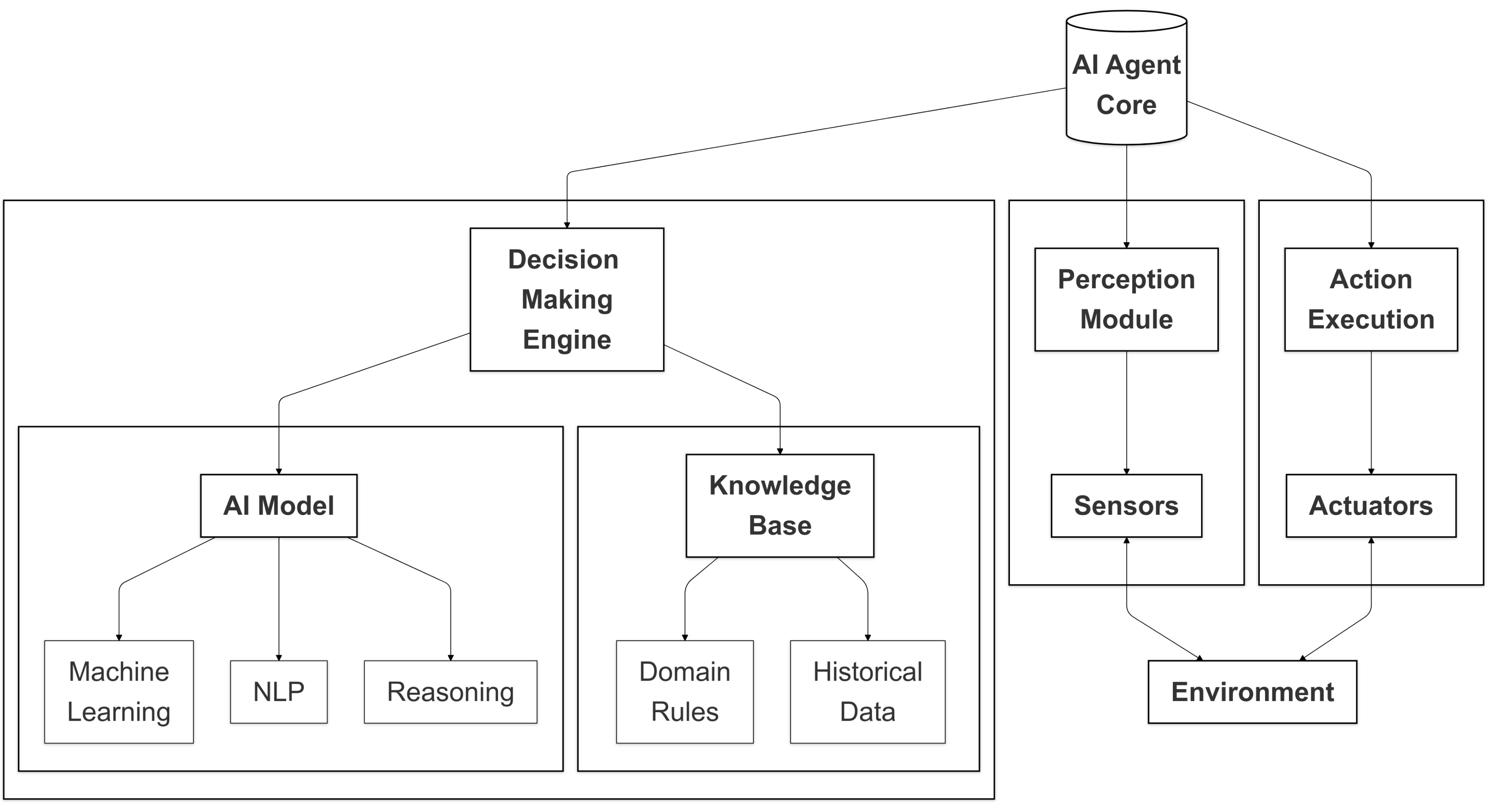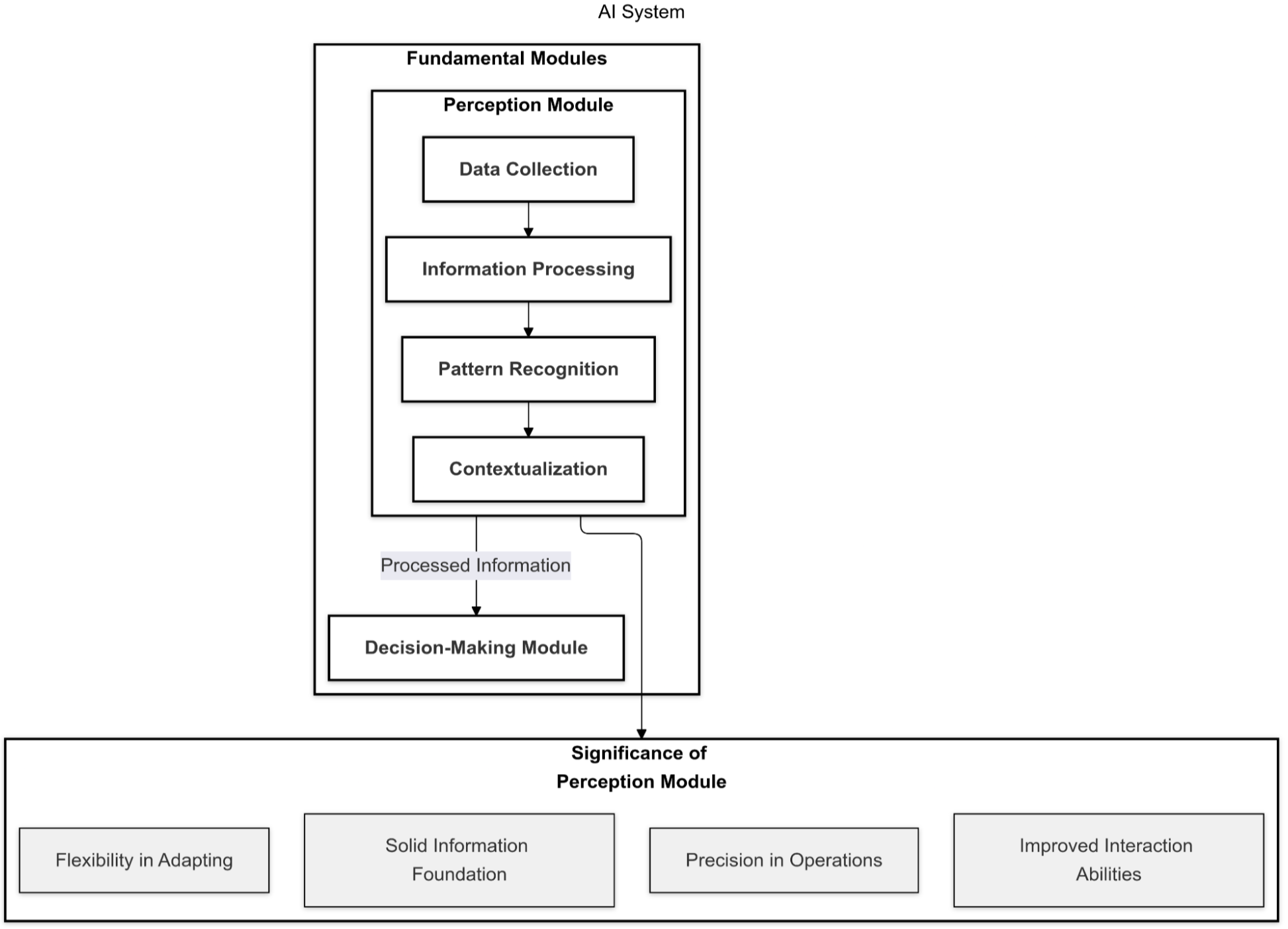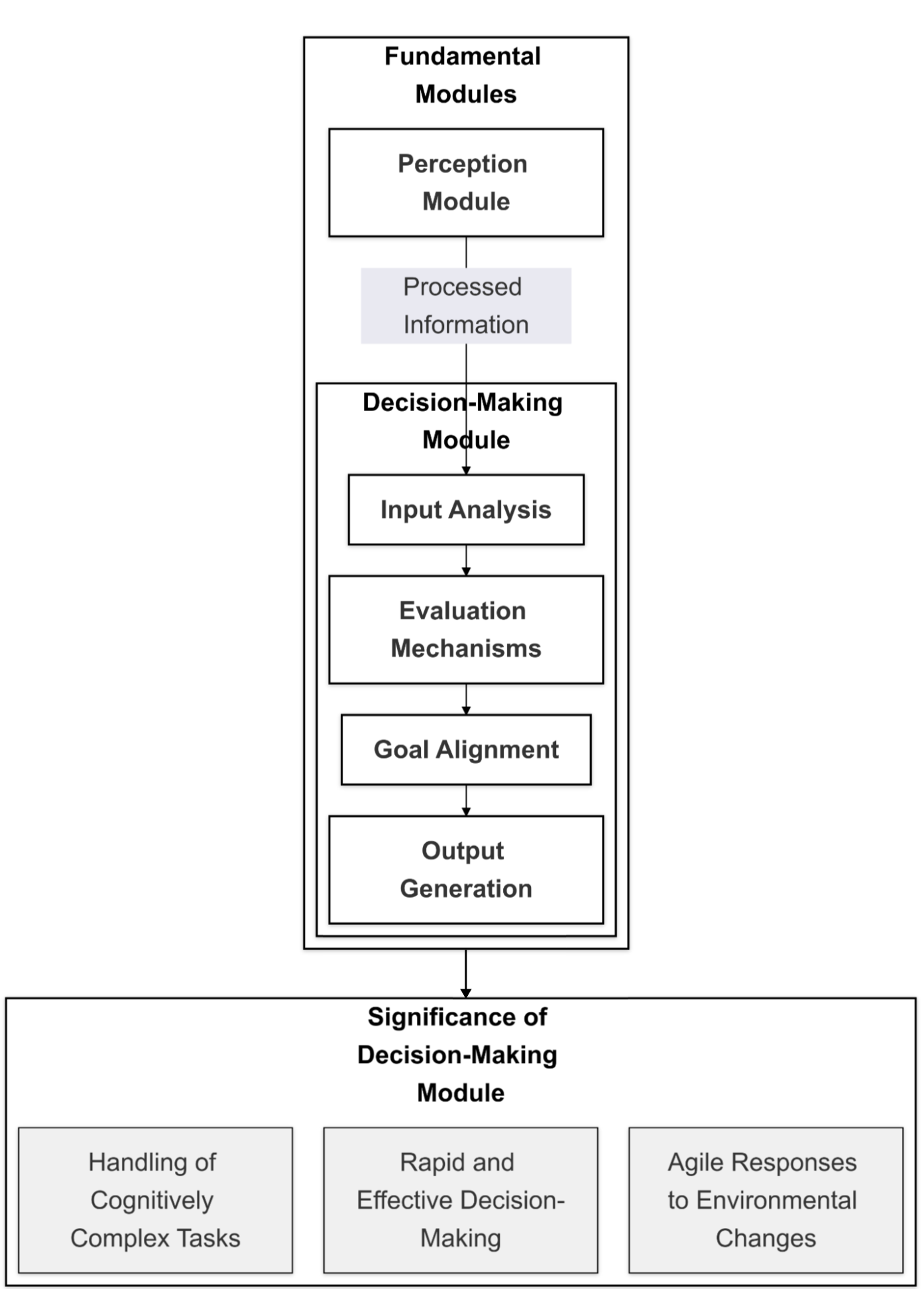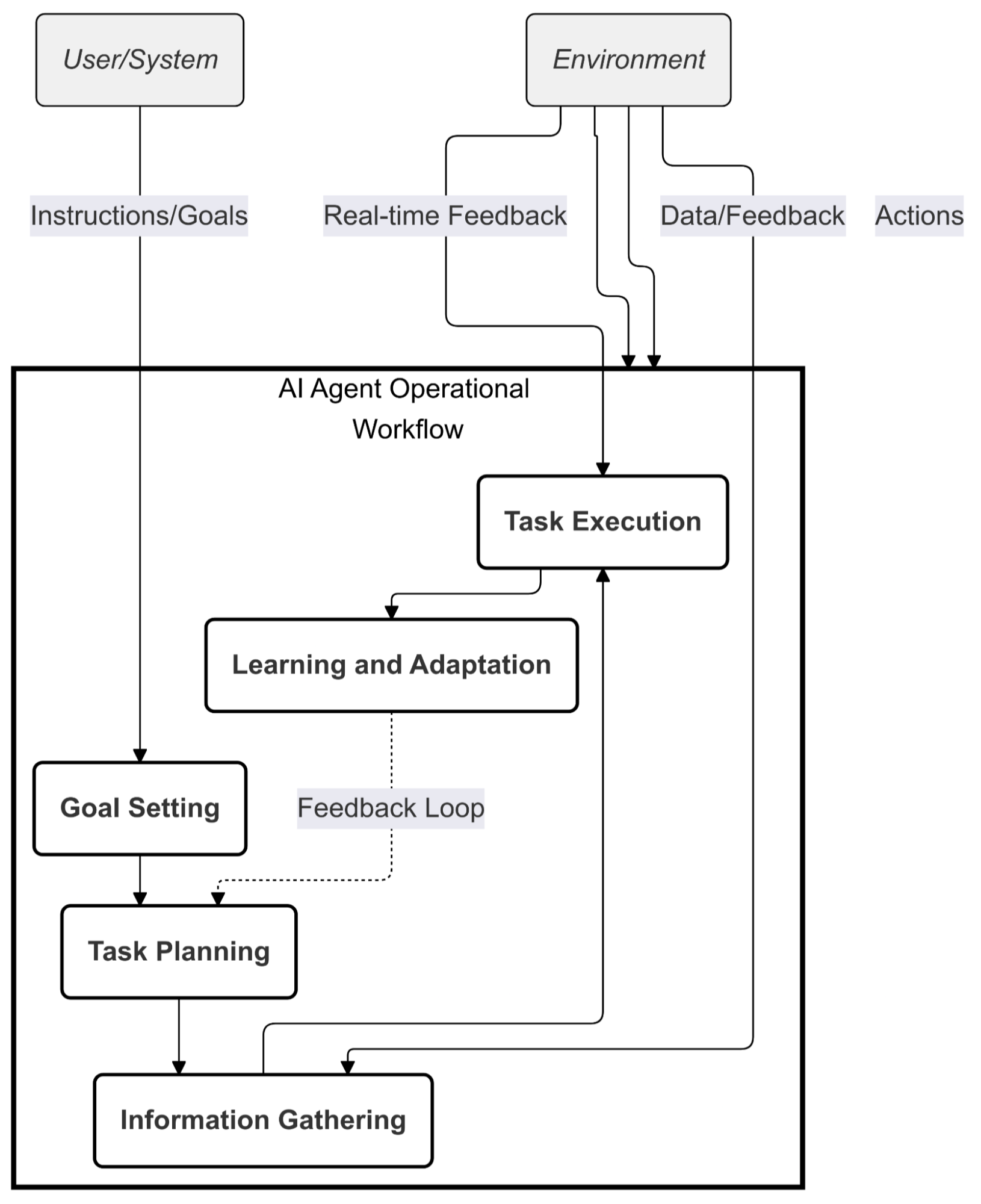Understanding AI Agents: The Future of Autonomous Task Execution
Index
- Defining AI Agents
- Fundamental Modules in AI Systems
Perception|Decision-Making|Synergy - Applications of AI Agents
Healthcare|Finance|Manufacturing|Retail|Transportation - Broader Implications
- Challenges and Ethical Considerations
- How AI Agents Operate
- Types of AI Agents
Simple Reflex|Model-Based Reflex|Goal-Based|Utility-Based|Learning Agents - Additional Categories of AI Agents
Hybrid|Social|Autonomous - Applications and Impact of AI Agents
- Challenges and Considerations
- The Future of AI Agents
- Historical Contributions to AI
- References
Artificial Intelligence (AI) agents signify a pivotal advancement in the realm of autonomous systems. These sophisticated software entities are engineered to autonomously perform tasks, making informed decisions and executing actions to achieve specific objectives without the necessity for continuous human oversight. This exploration delves into the fundamental principles, architecture, and transformative impact of AI agents across various industries.

Defining AI Agents
An AI agent is defined as a software program capable of perceiving its environment, processing information, and executing actions to meet predetermined goals. Distinct from traditional software, AI agents possess the capability to make rational decisions based on their perceptions and the dataavailable to them, thereby optimizing performance to yield the most favorable outcomes.

Fundamental Modules in Artificial Intelligence Systems: Perception and Decision-Making
Modern artificial intelligence (AI) systems are constructed on a complex architecture that comprises several interconnected modules. Among these, the perception module and the decision-making module are two of the most essential components, working together to enable AI systems to interact effectively with their environment and take appropriate actions.
The Perception Module: The Sensory System of AI
The perception module serves as the sensory interface of AI, responsible for collecting and processing data from the environment. This component is vital for the AI to gain an understanding of the world around it. Its primary functions include:
- Data Collection: Utilizes various sensors, both hardware (like cameras and microphones) and software (such as web scraping tools), to capture information from the environment.
- Information Processing: Transforms raw data into a structured format suitable for analysis by the AI.
- Pattern Recognition: Applies advanced algorithms to detect meaningful patterns and structures within the data.
- Contextualization: Provides a necessary framework for accurate interpretation of the information gathered.

The significance of the perception module lies in its ability to furnish a solid information foundation upon which the AI can operate. This capability enhances precision in operations, promotes flexibility in adapting to environmental changes, and improves the system's overall interaction abilities.
The Decision-Making Module: The Cognitive Engine of AI
Conversely, the decision-making module acts as the cognitive engine of the AI system, processing the information collected by the perception module to determine the most suitable actions. Its key components include:
- Input Analysis: Evaluates the data received from the perception module to identify relevant information.
- Evaluation Mechanisms: Utilizes various algorithms to assess the potential outcomes of different actions, ensuring effective decision-making.
- Goal Alignment: Verifies that the proposed actions align with the system's objectives and desired outcomes.
- Output Generation: Produces actionable instructions for the action execution system.

This module is fundamental to the operational efficiency of AI, enabling rapid and effective decision-making, agile responses to environmental changes, and the handling of cognitively complex tasks.
Synergy between Perception and Decision-Making
The interaction between the perception and decision-making modules facilitates intelligent and adaptive functioning in AI systems. The perception module provides essential data, while the decision-making module utilizes this information to determine the most appropriate actions. This synergy empowers AI to navigate complex and dynamic environments, adapt to new situations, and learn from experiences.
In summary, the perception and decision-making modules are critical components of modern AI system architecture. Their effective design and implementation are essential for developing AI systems capable of meaningful interaction with the real world and making informed, effective decisions.
Applications of AI Agents
AI agents are making transformative contributions across diverse sectors, enhancing efficiency, personalization, and decision-making. Here are some key areas where AI agents are currently employed:
-
Healthcare: AI agents are increasingly utilized for diagnostics, treatment planning, and patient care coordination. For example, IBM Watson Health analyzes vast amounts of medical literature and patient data to recommend personalized treatment options for cancer patients. Additionally, AI agents like chatbots are deployed in mental health applications to provide immediate support and therapeutic conversation, improving patient engagement and accessibility to care. References:
- Esteva, A., et al. (2019). "A Guide to Deep Learning in Healthcare." Nature Medicine, 25(1), 24-29. DOI: 10.1038/s41591-018-0276-3.
- Khasnabis, C. & et al. (2022). "Artificial Intelligence in Health Care: Anticipating Challenges to Ethics, Privacy, and Job Displacement." Healthcare, 10(3), 450-460. DOI: 10.3390/healthcare10030450.
-
Finance: In finance, AI agents are implemented in algorithmic trading systems to analyze market trends and execute trades autonomously based on complex mathematical models. Companies like Renaissance Technologies and Two Sigma use AI-driven algorithms to optimize trading strategies, improving returns on investments. Additionally, AI agents assist in fraud detection and risk assessment by analyzing transaction patterns and identifying anomalies in real-time.
References:- Aït-Sahalia, Y., & Saglam, M. (2020). "High-Frequency Trading and the New Paradigm in Financial Markets." Review of Financial Studies, 33(12), 5685-5712. DOI: 10.1093/rfs/hhaa022.
- Mallett, T. (2021). "The Rise of AI in Banking: How Machine Learning is Revolutionizing Financial Services." Journal of Economic Perspectives, 35(3), 179-198. DOI: 10.1257/jep.20190344.
-
Manufacturing: Autonomous robots are increasingly employed in manufacturing for quality control, assembly, and production efficiency. For instance, companies like Siemens and Tesla utilize AI-driven robotic systems to enhance manufacturing processes, streamline operations, and reduce waste. Additionally, predictive maintenance powered by AI agents helps anticipate equipment failures before they occur, minimizing downtime and maintenance costs. References:
- Wuest, T., et al. (2016). "The Role of Big Data in the Evolution of Manufacturing." Journal of Manufacturing Science and Engineering, 138(6), 061011. DOI: 10.1115/1.4032202.
- Lee, J., et al. (2020). "Industrial AI: Applications and Implications." IEEE Transactions on Industrial Informatics, 16(6), 4072-4080. DOI: 10.1109/TII.2020.2974864.
-
Retail: AI agents enhance customer experiences through personalized recommendations, inventory management, and sales forecasting. E-commerce platforms like Amazon use AI algorithms to analyze customer behavior and preferences, optimizing product suggestions and improving sales conversions. References:
- Kumar, A., & Gupta, R. (2020). "Applications of AI in E-commerce: The Role of Intelligent Agents." Journal of Retailing and Consumer Services, 55, 102132. DOI: 10.1016/j.jretconser.2020.102132.
-
Transportation: Autonomous vehicles, such as those developed by Waymo and Tesla, rely on AI agents to navigate complex environments, interpret real-time data, and make decisions on the road. AI is also employed in logistics to optimize delivery routes, reducing costs and improving efficiency in supply chain management.
References:- Krajzewicz, D., et al. (2012). "MATSim - A Multi-Agent Simulation of Transport Systems." Journal of Transport and Land Use, 5(1), 1-18. DOI: 10.5198/jtlu.v5i1.268.
- Shladover, S. E. (2018). "Connected and Automated Vehicle Systems: Introduction and Overview." Journal of Intelligent Transportation Systems, 22(3), 210-220. DOI: 10.1080/15472450.2018.1441751.
Broader Implications
AI agents are also making strides in diverse sectors such as agriculture, where they enhance precision farming techniques, in education through personalized learning experiences, and in entertainment via advanced content recommendation systems. The adaptability of AI agents paves the way for significant innovation and improved operational efficiency across these fields.
Moreover, the convergence of AI with blockchain and Web3 technologies presents an exciting frontier. This integration can drive exponential growth in applications by enhancing transparency, accountability, and security in digital transactions. For instance, AI can analyze data on blockchain networks to improve decision-making processes, while blockchain can ensure the integrity and traceability of AI-generated data.
-
Transparency and Accountability: The immutable nature of blockchain enhances the transparency of AI systems, allowing stakeholders to audit AI decisions and ensuring they adhere to ethical standards. This can help build trust in AI applications, particularly in sensitive areas like finance and healthcare.
-
Increased Efficiency: AI can optimize blockchain operations by automating processes such as smart contract execution and data verification. This efficiency can reduce costs and time, accelerating the deployment of decentralized applications (dApps) and services.
-
New Opportunities: The combination of AI and blockchain can create innovative business models, such as decentralized autonomous organizations (DAOs) that leverage AI for governance and operational efficiency. These models can transform industries, leading to new ways of organizing and delivering value in the digital economy Stanford AI Lab.
As we continue to explore the potential of AI agents within the context of blockchain and Web3, we are likely to see an expanding landscape of applications that drive further innovation. This union not only enhances existing technologies but also opens up new avenues for growth, fundamentally reshaping how we interact with and leverage technology in our daily lives.
Challenges and Ethical Considerations
While AI agents present numerous advantages, they also pose challenges and ethical considerations, such as the potential for job displacement, decision-making biases, and the necessity for transparency in AI operations. Addressing these issues is crucial for the sustainable development of AI technologies.
How AI Agents Operate
The operational workflow of an AI agent typically encompasses the following steps:
-
Goal Setting: The process begins when the agent receives a specific instruction or goal from a user or a connected system. This initial step establishes the parameters within which the agent will operate.
-
Task Planning: Once a goal is set, the agent decomposes this overarching objective into smaller, actionable tasks. This breakdown allows for a structured approach to achieving the end goal, facilitating easier management of the tasks involved .
-
Information Gathering: To effectively accomplish its tasks, the agent collects necessary data from a variety of sources. This may include databases, the internet, or data provided by other AI systems. The ability to gather and process relevant information is crucial for informed decision-making Stanford AI Lab.
-
Task Execution: The agent systematically executes each identified task while continuously monitoring its progress toward the overall goal. This step often involves iterative processes, where the agent may need to adjust its actions based on real-time feedback from its environmentWikipedia.
-
Learning and Adaptation: Advanced AI agents incorporate learning mechanisms that allow them to adapt their strategies based on past experiences. This capacity for continuous improvement enables agents to enhance their performance over time, making them more effective in dynamic environments .

Types of AI Agents
-
Simple Reflex Agents:
- These agents operate based on current percepts and predefined rules. They respond directly to specific stimuli without any memory of past states, which limits their ability to handle complex scenarios.
- Example: A thermostat that turns on when the temperature falls below a certain threshold.
- Learn more about simple reflex agents.

-
Model-Based Reflex Agents:
- These agents maintain an internal model of the world to keep track of the current state. They use this model to make decisions based on both current and past percepts, allowing for more sophisticated behavior than simple reflex agents.
- Example: An automated vacuum that maps a room and avoids obstacles based on its internal representation.
- Explore model-based reflex agents.

- Goal-Based Agents:
- Goal-based agents can assess various possible actions and choose the one that best achieves their objectives. They are capable of considering future states and planning accordingly.
- Example: A chess-playing program that evaluates potential moves to achieve a checkmate.
- Find out more about goal-based agents.

- Utility-Based Agents:
- These agents not only aim to achieve goals but also consider the desirability of different outcomes. They make decisions that maximize a utility function, allowing for more nuanced decision-making in uncertain environments.
- Example: A stock trading algorithm that evaluates risk and reward to make investment decisions.
- Learn about utility-based agents.

- Learning Agents:
- Learning agents can adapt their behavior based on past experiences and improve their performance over time. They often utilize machine learning techniques to enhance their capabilities.
- Example: A recommendation system that learns user preferences to suggest relevant content.
- Explore learning agents.

Some of the most prevalent types of AI agents, showcasing how each category represents a unique approach to processing information and interacting with its environment. From the straightforward logic of reflex agents to the nuanced decision-making of utility-based systems, and the adaptive capabilities of learning agents.

Additional Categories of AI Agents
-
Hybrid Agents: Hybrid agents integrate various strategies, such as reactive and deliberative approaches, to strike a balance between immediate responsiveness and higher-level reasoning. By combining these strategies, hybrid agents can adapt quickly to changing environments while also engaging in more complex planning and decision-making processes. This flexibility makes them particularly useful in dynamic situations where both quick reactions and strategic foresight are required. For instance, a hybrid agent in a robotics context might react swiftly to obstacles while planning its route to a destination simultaneously.
-
Social Agents: Social agents are designed to interact with humans and other agents, incorporating social skills that facilitate cooperation and effective communication. These agents can engage in dialogue, understand emotional cues, and adapt their behavior based on social contexts. Applications for social agents range from virtual customer service representatives to AI companions in mental health settings. The ability of social agents to build rapport and trust can significantly enhance user experience and engagement.
-
Autonomous Agents: Autonomous agents are capable of operating independently within complex environments. They utilize advanced AI techniques, including machine learning and sensor integration, to navigate real-world scenarios without human intervention. Autonomous agents are prevalent in applications such as self-driving vehicles, drone navigation, and robotic process automation in manufacturing. Their ability to make decisions based on real-time data allows them to operate efficiently and safely in unpredictable conditions.

Applications and Impact of AI Agents
AI agents are transforming a multitude of industries by enhancing efficiency, optimizing processes, and improving user experiences:
-
Customer Service: AI agents, such as chatbots and virtual assistants, are revolutionizing customer interactions across digital platforms. They provide 24/7 support, resolve common queries, and enhance customer satisfaction by offering quick, efficient service.
-
Healthcare: In the medical field, AI agents assist in treatment planning, medication management, and care coordination. They analyze patient data to provide personalized recommendations, improve diagnostic accuracy, and streamline administrative processes, ultimately contributing to better patient outcomes.
-
Emergency Response: During disaster scenarios, AI agents can play a crucial role by locating affected individuals and coordinating rescue efforts. They analyze real-time data from various sources, such as social media and satellite imagery, to facilitate more effective emergency management.
-
Business Operations: AI agents are automating complex tasks across business operations, from supply chain management to human resources. By optimizing workflows, these agents not only improve productivity but also reduce operational costs, allowing organizations to allocate resources more effectively.
Challenges and Considerations
Despite their vast potential, the implementation of AI agents presents several challenges that must be addressed:
-
Data Privacy: Ensuring the security and proper handling of sensitive information is paramount. Organizations must navigate regulations such as GDPR while maintaining user trust.
-
Ethical Concerns: AI agents can inadvertently perpetuate biases present in their training data, leading to unfair decision-making. It is crucial to develop mechanisms for transparency and accountability in AI systems.
-
Technical Complexity: The development and maintenance of sophisticated AI systems require specialized expertise. This complexity can pose barriers to entry for smaller organizations.
-
Resource Requirements: Advanced AI agents often demand substantial computational resources, which can limit their accessibility and scalability for some applications.
The Future of AI Agents
As AI technology continues to advance, we can anticipate AI agents becoming increasingly sophisticated, capable of managing more complex tasks across diverse applications. Their integration into daily life and business operations is set to drive innovation, enhance efficiency, and unlock new avenues for problem-solving and decision-making .
In conclusion, AI agents represent a formidable force in the ongoing digital transformation of our world. As we refine and expand their capabilities, the potential for AI agents to fundamentally change how we work, live, and interact with technology is truly remarkable.
Historical Contributions to Artificial Intelligence
The evolution of artificial intelligence (AI) has been marked by pivotal contributions from various researchers and theorists, each adding a layer of understanding that has shaped the field into what it is today.
From early theories of knowledge representation to the latest advancements in deep learning, these contributions reflect a journey of innovation that continuously transforms our approach to intelligent systems. Below is a comprehensive overview of key figures and their seminal work that laid the groundwork for contemporary AI.
- Allen Newell and Herbert A. Simon (1976): Their work on physical symbol systems established the foundations for knowledge representation in AI. Learn more here.
- John Hopfield (1982): Introduced Hopfield networks, which implemented associative memory in neural systems, crucial for AI learning and information retrieval. Learn more here.
- Geoffrey Hinton et al. (1986, 2006): Their research on backpropagation and deep belief networks revolutionized machine learning. More on backpropagation and deep learning.
- Rodney Brooks (1987): Proposed "intelligence without representation," influencing reactive robotic agents. More on Brooks' approach.
- Michael Bratman, Anand Rao, and Michael Georgeff (1987, 1995): Developed the BDI architecture, allowing agents to have beliefs, desires, and intentions. Explore BDI architecture.
- Multi-agent systems (1980s): Carl Hewitt and Les Gasser laid the groundwork for cooperation among multiple AI agents. More on multi-agent systems.
- Pattie Maes (1994): Introduced intelligent personal assistants, anticipating many modern applications of AI agents. Learn about Maes' contributions.
- Stuart Russell and Peter Norvig (1995): Their book provided a unified taxonomy of AI agents, significantly influencing the field. Explore their book.
- Innes Ferguson (1995): Proposed a hybrid architecture for autonomous agents, combining reactive and deliberative approaches. More on hybrid architectures.
- KQML (1990s): This agent communication language facilitated interoperability in multi-agent systems. Learn more about KQML.
- Marvin Minsky (1986): His "Society of Mind" proposed a theory of intelligence based on simple agents' interaction. More on Minsky's theories.
- Stan Franklin and Art Graesser (1996): Developed a taxonomy of autonomous agents, clarifying different types of AI agents. Learn more here.
- Nicholas R. Jennings and Michael Wooldridge (1990s): Their contributions helped establish multi-agent systems as a mature research field in AI. More on their contributions.
- Jürgen Schmidhuber: His work on Long Short-Term Memory (LSTM) networks has been pivotal in advancing deep learning, especially for sequence prediction tasks. Learn more here.
- Andrew Ng: A pioneer in online education and deep learning, Ng has significantly contributed to AI applications in various domains. Explore Ng's contributions.
- Yoshua Bengio: His research in deep learning has focused on generative models and unsupervised learning. More on Bengio's work.
- Fei-Fei Li: Her work in computer vision, particularly the ImageNet project, has advanced deep learning applications in visual recognition. Learn about Li's contributions.
- Norbert Wiener: Often regarded as the father of cybernetics, his work laid the groundwork for understanding feedback systems in machines. More on Wiener's contributions.
This comprehensive list captures both historical and modern contributions to AI, illustrating how the field has evolved through various significant theories, architectures, and applications.
References
1. Russell, S., & Norvig, P. (2020). Artificial Intelligence: A Modern Approach. Pearson. Learn more. 2. Poole, D., & Mackworth, A. (2017). Artificial Intelligence: Foundations of Computational Agents. Cambridge University Press. Explore here. 3. Brooks, R. A. (1991). "Intelligence Without Representation." Artificial Intelligence, 47(1-3), 139-159. Read more. 4. Minsky, M. (1986). The Society of Mind. Simon & Schuster. Find out more. 5. S. Thrun, W. Burgard, D. Fox. (2005). Probabilistic Robotics. MIT Press. More info. 6. Sutton, R. S., & Barto, A. G. (2018). Reinforcement Learning: An Introduction (2nd ed.). MIT Press. Learn more 7. Wooldridge, M. (2009). An Introduction to MultiAgent Systems (2nd ed.). John Wiley & Sons. More info 8. J. M. P. & D. M. (2020). "Artificial Intelligence in Health Care: Anticipating Challenges to Ethics, Privacy, and Job Displacement." Healthcare. Read the article. 9. Goldstein, M. A., Kumar, P., & Graves, F. C. (2014). "Computerized and High-Frequency Trading." Financial Review, 49(2), 177-202. Learn more 10. H. S. G. C. M. (2020). "Ethical Implications of AI and Automation." Journal of Business Ethics. Discover more. 11. Binns, R. (2018). "Fairness in Machine Learning: Lessons from Political Philosophy." Proceedings of the 1st Conference on Fairness, Accountability and Transparency, PMLR 81:149-159. Learn more 12. Brynjolfsson, E., & McAfee, A. (2014). The Second Machine Age: Work, Progress, and Prosperity in a Time of Brilliant Technologies. W. W. Norton & Company. Explore the book. 13. Amodei, D., & Garnett, T. (2018). "AI and Compute." OpenAI Blog. Learn more.